The AMD Trinity Review (A10-4600M): A New Hope
by Jarred Walton on May 15, 2012 12:00 AM ESTAMD Trinity General Performance
Starting as usual with our general performance assessment, we’ve got several Futuremark benchmarks along with Cinebench and x264 HD encoding. The latter two focus specifically on stressing the CPU while PCMarks will cover most areas of system performance (including a large emphasis on storage) and 3DMarks will give us a hint at graphics performance. First up, PCMark 7 and Vantage:
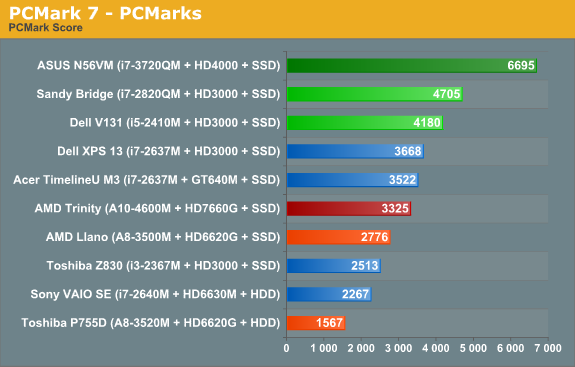
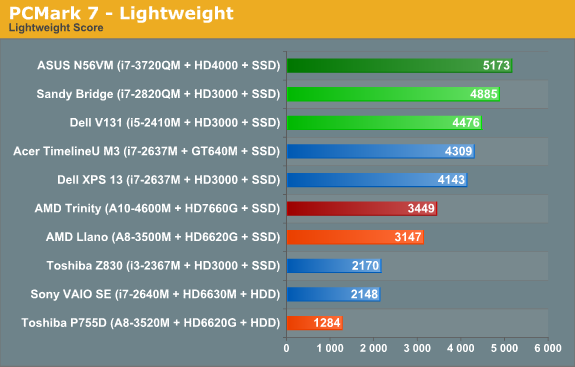
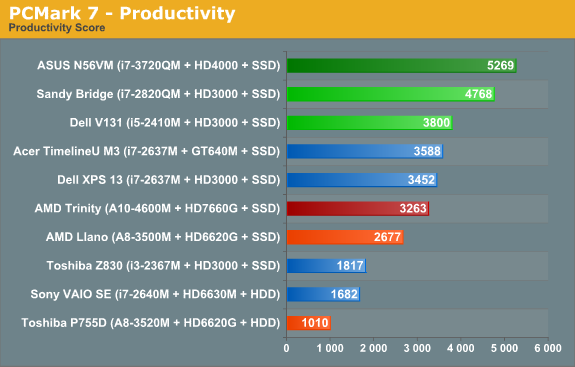

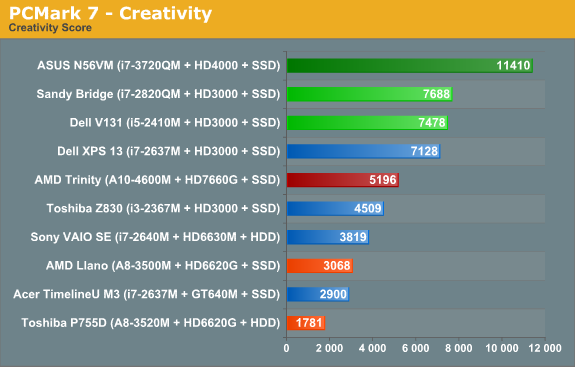
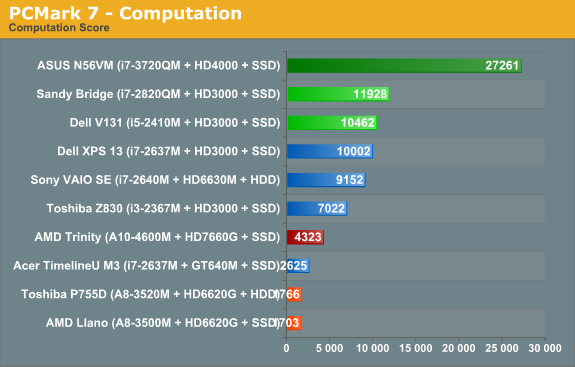
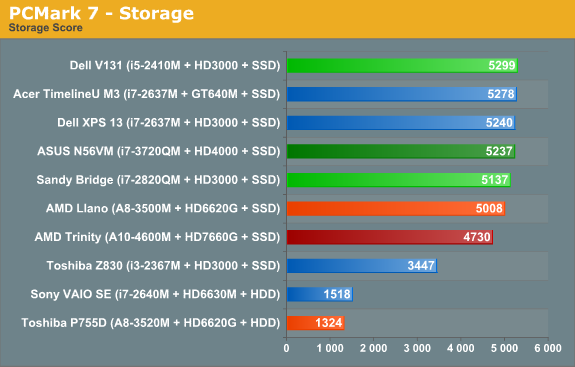
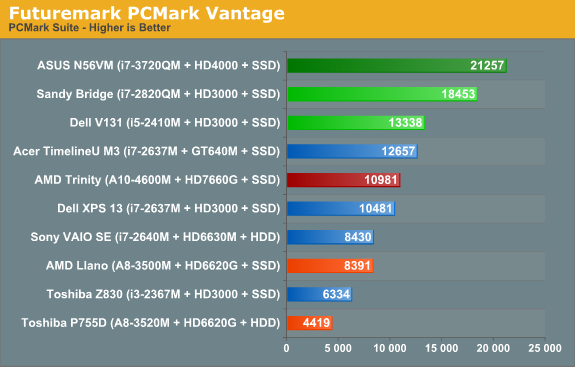
As noted earlier, we ran several other laptops through PCMark 7 and PCMark Vantage testing using the same Intel 520 240GB SSD, plus all the ultrabooks come with SSDs. That removes the SSD as a factor from most of the PCMark comparisons, leaving the rest of the platform to sink or swim on its own. And just how does AMD Trinity do here? Honestly, it’s not too bad, despite positioning within the charts.
Obviously, Intel’s quad-core Ivy Bridge is a beast when it comes to performance, but it’s a 45W beast that costs over $300 just for the CPU. We’ll have to wait for dual-core Ivy Bridge to see exactly how Intel’s latest stacks up against AMD, but if you remember the Llano vs. Sandy Bridge comparisons it looks like we’re in for more of the same. Intel continues to offer superior CPU performance, and even their Sandy Bridge ULV processors can often surpass Llano and Trinity. In the overall PCMark 7 metric, Trinity ends up being 20% faster than a Llano A8-3500M laptop, while Intel’s midrange i5-2410M posts a similar 25% lead on Trinity. Outside of the SSD, we’d expect Trinity and the Vostro V131 to both sell for around $600 as equipped.
A 25% lead for Intel is pretty big, but what you don’t necessarily get from the charts is that for many users, it just doesn’t matter. I know plenty of people using older Core 2 Duo (and even a few Core Duo!) laptops, and for general office tasks and Internet surfing they’re fine. Llano was already faster in general use than Core 2 Duo and Athlon X2 class hardware, and it delivered great battery life. Trinity boosts performance and [spoiler alert!] battery life, so it’s a net win. If you’re looking for a mobile workstation or something to do some hardcore gaming, Trinity won’t cut it—you’d want a quad-core Intel CPU for the former, and something with a discrete GPU for the latter—but for everything else, we’re in the very broad category known as “good enough”.


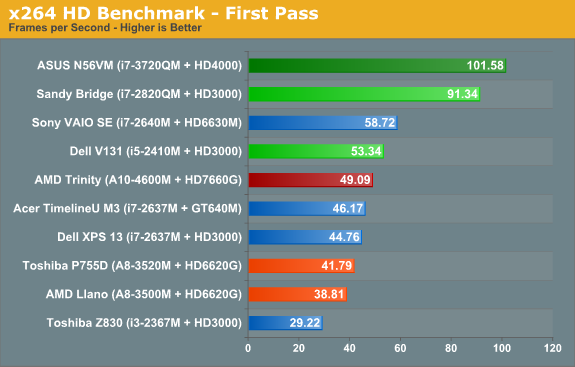
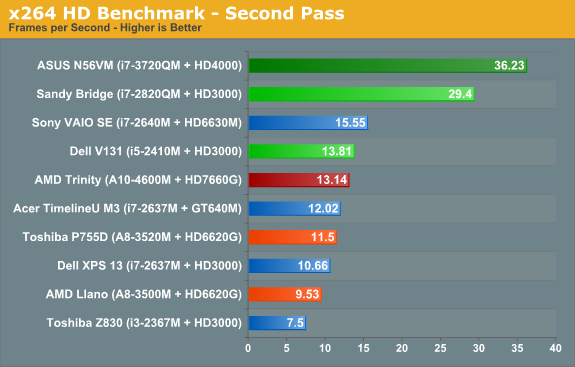
When we start drilling down into other performance metrics, AMD’s CPU performance deficiency becomes pretty obvious. The Cinebench single-threaded score is up 15% from 35W Llano, but in a bit of a surprise the multi-threaded score is basically a wash. Turn to the x264 HD encoding test however and Trinity once again shows a decent 15% improvement over Llano. Against Sandy Bridge and Ivy Bridge, though? AMD’s Trinity doesn’t stand a chance: i5-2410M is 50% faster in single-threaded Cinebench, 27% faster in multi-threaded, and 5-10% faster in x264. It’s a good thing 99.99% of laptop users never actually run applications like Cinebench for “real work”, but if you want to do video encoding a 10% increase can be very noticeable.

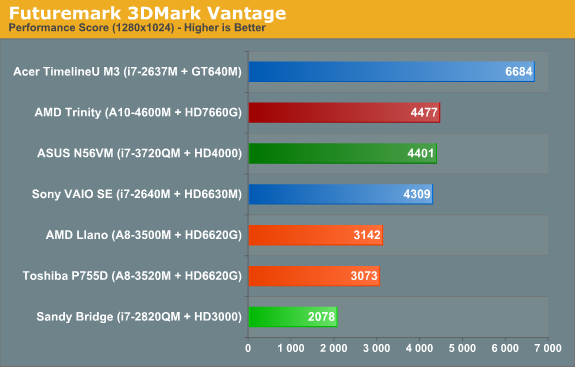
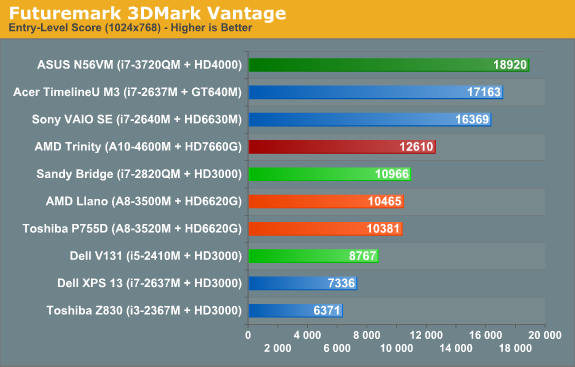
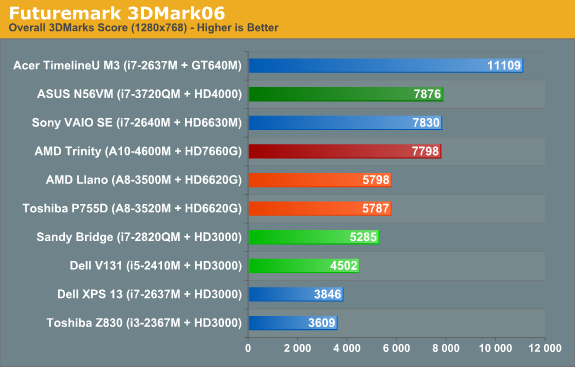
Shift over to graphics oriented benchmarks and the tables turn once again...sort of. Sandy Bridge can’t run 3DMark11, since it only has a DX10 class GPU, but in Vantage Performance and 3DMark06 Trinity is more than twice as fast as HD 3000. Of course, Ivy Bridge’s HD 4000 is the new Intel IGP Sheriff around these parts, and interestingly we see Trinity and i7-3720QM basically tied in these two synthetics. (We’ll just ignore 3DMark Vantage’s Entry benchmark, as it’s so light on graphics quality that we’ve found it doesn’t really stress most GPUs much—even low-end GPUs like HD 3000 score quite well.) We’ll dig into graphics performance more with our gaming benchmarks next.










271 Comments
View All Comments
KompuKare - Tuesday, May 15, 2012 - link
What AMD really needs is a better IMC. Look at this recent computerbase article on IB and RAM:http://www.computerbase.de/artikel/arbeitsspeicher...
http://translate.google.co.uk/translate?hl=en&...
Unlike Llano IB doesn't perform a lot different as long it's running at DDR3-1600. Which to me says that Intel's IMC is a lot more efficient than AMD's. Ironic I know since AMD brought IMC to the x86 space, but the problem is that Intel have such a huge R&D budget compared to AMD.
I'll be interested in Jarred trying that review sample with DDr3-1333 too.
Assimilator87 - Tuesday, May 15, 2012 - link
A piece of my soul was crushed when I saw the HD 4000 ahead of Trinity. I don't care what the situation is, that should NEVER happen. 22nm and GCN can't come soon enough.ET - Tuesday, May 15, 2012 - link
While the HD 4000 still gets too low performance on occasion, I was generally impressed with it in this comparison. Intel GPUs have come a long way.As for Trinity, it looks like a well rounded solution. I'm more interested in the 17W version, as an alternative to Brazos. I like my Thinkpad x120e, and even run games on it occasionally, but it's still pretty weak.
ET - Tuesday, May 15, 2012 - link
"PCI Express support in Trinity remains at PCEe 2.0"althaz - Tuesday, May 15, 2012 - link
I'd pay $700 for an ultrabook-type laptop with this in it - provided it had a 128Gb Samsung SSD, a decent keyboard and an above-average screen.Ideally I'd like to get a convertible tablet with windows 8 on it powered by this. In laptop mode it's a portable gaming machine, in tablet mode a pretty nice tablet. Something 11.6"ish akin to the Transformer Prime from Asus in form factor
Riek - Tuesday, May 15, 2012 - link
Would it be possible to include power consumption (or batterly life) while gaming?Would it also be possible to add a cpu frequency - gpu frequency graph during some workloads? To see how turbo3.0 shapes up and how well the gpu turbo is implemented and used?
From my understanding gpu gets priority in turbo, but a trinity at 2.3GHz will just limit the performance in gaming. I wonder if the turbo is shaped up like that.
JarredWalton - Tuesday, May 15, 2012 - link
I noted battery life while looping 3DMark06 was 77 minutes. If we calculate power draw, that works out to around 43W. I also just checked AC power draw at the outlet during the same test, and the average power use was around 50W (45-55W range, but mostly right around 50). Accounting for AC adapter inefficiencies, if it's 80-85% efficient the laptop is using around 40-43W.Riek - Tuesday, May 15, 2012 - link
Yeah looked over that. So gaming wise llano is still a better option in regards to batterly life (alot better).Sandy bridge would be the worst choice. (as it gives the worst performance).
I'm suprised trinity and IvyB are so close in terms of 3dmark06 performance and battery life.
deathpony - Tuesday, May 15, 2012 - link
Hi, i have an AMD A6-3500http://valid.canardpc.com/show_oc.php?id=2369937
Gigabyte GA-A75M-UD2H
AMD Radeon HD 6530D
http://www.techpowerup.com/gpuz/63we6/
For some reason i was able to Undervolt the APU and push the clock to 2 Ghz while retaining stability. Also by raising the clock this much i got performance increase in double digits, can you test it out with Trinity? Thanks!
JarredWalton - Tuesday, May 15, 2012 - link
Unfortunately, the Trinity BIOS is pretty much useless as far as undervolting/overclocking/etc. are concerned. I'd be interested in testing such items, but we'd need a far more capable BIOS/motherboard than this laptop has.